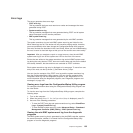
Chapter 5. Diagnostics
This chapter describes the diagnostic tools that are available to help you solve
problems that might occur in the server.
If you cannot diagnose and correct a problem by using the information in this
chapter, see Appendix A, “Getting help and technical assistance,” on page 247 for
more information.
Diagnostic tools
The following tools are available to help you diagnose and solve hardware-related
problems:
v POST beep codes, error messages, and error logs
The power-on self-test (POST) generates beep codes and messages to indicate
successful test completion or the detection of a problem. See “POST” for more
information.
v Troubleshooting tables
These tables list problem symptoms and actions to correct the problems. See
“Troubleshooting tables” on page 147.
v Server LEDs
Use the LEDs on the server to diagnose system errors quickly. See “Error LEDs”
on page 160 for more information.
v Diagnostic programs and messages
The diagnostic programs on the Diagnostics CD are the primary method of
testing the major components of the server. See “Diagnostic programs and
messages” on page 163 for more information.
POST
When you turn on the server, it performs a series of tests to check the operation of
the server components and some optional devices in the server. This series of tests
is called the power-on self-test, or POST.
If a power-on password is set, you must type the password and press Enter, when
you are prompted, for POST to run.
If POST is completed without detecting any problems, one short beep occurs, and
the server startup is completed.
If POST detects a problem, several beeps might sound, or an error message is
displayed. See “POST beep codes” on page 130 and “POST error codes” on page
135 for more information.
© Lenovo 2008. Portions © IBM Corp. 2008. 129


















